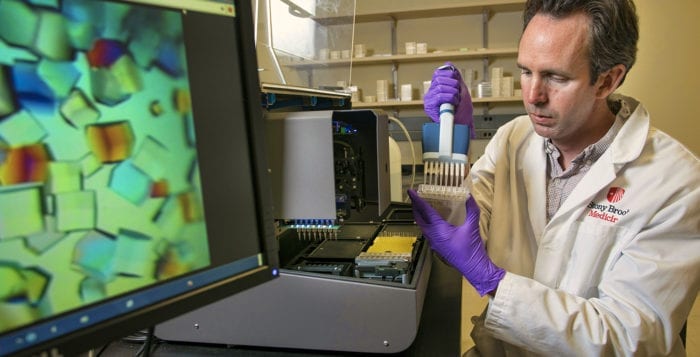By Daniel Dunaief
Numerous trucks arrive at a construction site, each doing their part to make a blueprint for a building into a reality. In a destructive way, molecules also come together in cancer to change cells that cause damage and can ultimately kill.
Researchers often know the participants in the cancer process, although the structure of each molecule can be a mystery. Determining how the parts of an enzyme work could allow scientists and, eventually, doctors to slow those cancer players down or inactivate them, stopping their cell-damaging or destroying processes.
Recently, Michael Airola, who started his own lab at Stony Brook University early this year and is an assistant professor of biochemistry and cell biology, published a paper in the Proceedings of the National Academy of Sciences in which he showed the structure of an important enzyme that contributes to cell growth regulation in cancer and other diseases, including Alzheimer’s disease.
Called neutral sphingomyelinase, this enzyme produces ceramide, which allows cancer cells to become metastatic. Finding the structure of an enzyme can enable scientists to figure out the way it operates, which can point to pharmacological agents that can inhibit or deactivate the enzyme.
“We are trying to understand the link between structure and function to try to get the first sort of snapshots or pictures of what these enzymes look like” in the on and off states, said Airola. In his research, he showed what this enzyme looked like in its off or inactive state.
Airola joined Stony Brook Cancer Center Director Yusuf Hannun’s lab as a postdoctoral researcher in 2010, when Hannun was working in Charleston, South Carolina, at the Medical University of South Carolina. When Hannun moved to SBU in March of 2012, Airola joined him, continuing his postdoctoral research.

Airola conducted his research at Stony Brook and Brookhaven National Laboratory, where he used a technique called X-ray crystallography, which shows the structure of crystallized molecules. Getting this enzyme to crystallize took considerable effort, especially because it has what Airola described as a floppy segment between two rigid structures.
Those floppy pieces, which Airola said aren’t the active sites of the enzyme, can interfere with the structural analysis. To see the important regions, Airola had to cut those flexible parts out, while fusing the rest of the enzyme into a single structure.
The crystallization took almost three years and was a “very difficult process,” Airola recounted. “To get proteins to crystallize, you need to get them to pack together in an ordered fashion.” He said he needed to develop some biochemical tricks to delete a large part in the middle of the protein. “Once we found the right trick and the right region to delete, we were able to crystallize the protein in about three months.”
Airola said he took considerable care to make sure removing the floppy or flexible region didn’t disrupt the function of the enzyme. Hannun and Airola are co-mentoring Prajna Shanbhogue, a graduate student who is in the process of discovering molecules that activate and inhibit the enzyme.
Hannun was pleased with the work Airola did in his lab, which he suggested was a “challenging type of research. Getting to a structure of a protein or enzyme (a specific type of protein) can take several years and is never guaranteed of success, but the rewards can be tremendous,” Hannun explained in an email, adding that Airola was a “critical contributor” and introduced structural biology to his group.
While Airola will continue to work on this enzyme, he is exploring another enzyme, in a collaboration with Hannun and John Haley at Stony Brook, that is involved in colon cancer.
Airola, two graduate students and three undergraduates in his lab are focusing considerable energy on an enzyme involved in the production of triglycerides.
Airola recently received a three-year, $231,000 grant from the American Heart Association to study lipins, a class of enzyme that plays a role both in heart disease and in diabetes. As he did with the enzyme that makes ceramide, Airola is developing a way to understand the structure and function of the triglyceride enzyme. He’d like to find out how this enzyme is regulated. “We’re trying to see if we can inhibit that enzyme, too,” he said.
Airola has “some creative ideas about using information from lipin proteins in plants and fungi, which have a less complex protein structure than mammalian lipins but catalyze the same biochemical reaction,” Karen Reue, a professor in the Department of Human Genetics, David Geffen School of Medicine at UCLA and a collaborator with Airola, explained in an email.
Reue’s lab will complement Airola’s work by conducting physiological analyses of the various “minimal” lipin proteins in processes that the mammalian proteins perform, including triglyceride biosynthesis.
While lipin proteins are necessary for metabolic homeostasis, Reue said a reasonable but still challenging goal might be to modulate the enzyme’s activity for partial inhibition in areas such as adipose tissue, while allowing the triglycerides to perform other important tasks.
Airola lives in East Setauket with his wife Krystal Airola, who is doing her residency in radiology at SBU, and their two children, four-year-old Harper and two-year-old Grady. The couple, who is expecting a third child next month, enjoy living in East Setauket, where they appreciate that they have a forest in their backyard and they can enjoy the water in Port Jefferson and West Meadow Beach.
When Airola’s postdoctoral position ended, he did a broad, national search for his next position and was delighted that he could remain at Stony Brook. “We love the area,” he said. “The research and science here are fantastic.” Airola’s collaborators are optimistic about the prospects for his research.
He is an “up and coming structural biologist that has already made important contributions to the field of lipid biology” Reue said and is a “creative and rigorous scientist with a bright future.”





